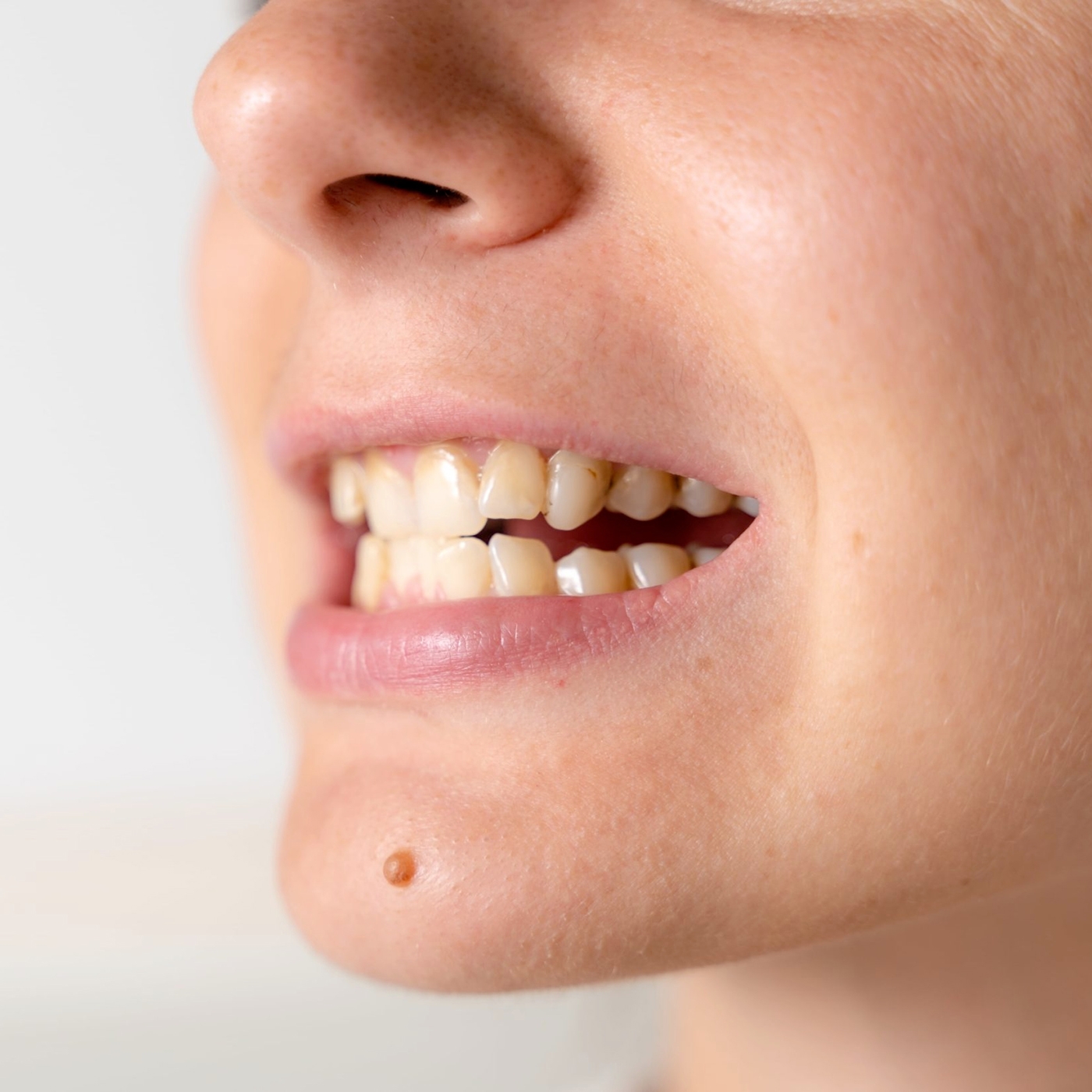What Are the Different Types of Malocclusions?
Ever looked in the mirror and wondered if your bite is “normal”? Maybe your teeth seem crowded, or perhaps your front teeth don’t line up quite right. These are telltale signs of malocclusion, which simply means your teeth are misaligned.
Don’t worry, you’re not alone! Malocclusions are actually quite common, affecting people of all ages. While they might not always cause problems, understanding the different types and their potential impact can help you make informed decisions about your oral health.
All Different Types of Malocclusions
Think of a perfect bite like two sets of interlocking gears. When your upper and lower teeth meet and fit together smoothly, you have a normal occlusion. But when this alignment is off, it’s called a malocclusion.
There are different types of malocclusions, each classified based on the relationship between your upper and lower jaws:
- Overcrowding: Imagine a bustling city where buildings are squeezed together. That’s what overcrowding feels like for your teeth! When your jaw doesn’t have enough space to accommodate all your teeth comfortably, they start to overlap and push against each other, creating a crowded appearance. This can lead to difficulty cleaning your teeth properly, increasing the risk of cavities and gum disease. Additionally, misaligned teeth can put uneven pressure on your jaw, potentially causing discomfort or pain.
- Spacing: Spacing is the opposite of overcrowding, where gaps appear between your teeth. This can be caused by missing teeth, a larger jawbone than necessary, or even habits like thumb-sucking in childhood. While some spacing might not pose significant problems, larger gaps can affect your speech and make it harder to chew efficiently. Additionally, they can trap food particles, making regular cleaning even more crucial.
- Crossbite: Imagine a puzzle where pieces don’t fit together quite right. That’s the idea behind a crossbite. In this type of malocclusion, some of your upper teeth bite inside or outside your lower teeth when you close your mouth. This can happen on one or both sides of your jaw and can affect both your front and back teeth. Crossbites can lead to uneven wear and tear of teeth, jaw joint problems, and even difficulty chewing.
- Open Bite: Picture a sandwich where the top and bottom slices don’t quite touch. That’s similar to an open bite, where your upper and lower front teeth don’t meet when you close your mouth, leaving a vertical gap. This can be caused by factors like thumb-sucking, tongue-thrusting, or even genetics. Open bites can affect your speech, make it harder to bite and chew certain foods, and even impact your appearance.
- Impacted Tooth: Imagine a shy party guest who never shows up. That’s similar to an impacted tooth! This occurs when a tooth, usually a wisdom tooth, fails to erupt (emerge) from the gum line and remains stuck within the jawbone or soft tissue. This can happen for various reasons, including lack of space, improper angulation of the tooth, or even dense bone blocking its path. While impacted teeth might not always cause immediate problems, they pose potential threats in the long run. They can:
- Crowd and misalign other teeth: Even if the impacted tooth isn’t visible, it can put pressure on surrounding teeth, causing them to shift and become misaligned.
- Damage surrounding teeth: In some cases, an impacted tooth can press against the roots of nearby teeth, causing damage or even leading to their loss.
- Cause infection: Impacted teeth are more susceptible to infection as they’re difficult to clean properly, potentially leading to pain, swelling, and even cyst formation.
- Leading to jaw pain: Depending on the location and angulation of the impacted tooth, it can put pressure on the jawbone and surrounding tissues, contributing to discomfort or pain.
So, early detection and treatment of impacted teeth are crucial.
What Causes Malocclusion?
Now that we’ve explored different types of malocclusions, let’s delve into what might cause them and the potential consequences they can have:
- Genetics: Your genes play a significant role in determining your jaw size and tooth shape. If these inheritances don’t perfectly align, a malocclusion can develop.
- Early childhood habits: Habits like prolonged thumb sucking, tongue thrusting, or using a pacifier after the age of 3 can put pressure on developing teeth and jaws, potentially leading to misalignment.
- Missing teeth: If you lose a baby tooth prematurely, the surrounding teeth might shift to fill the gap, causing crowding or misalignment when permanent teeth erupt.
- Extra teeth: Sometimes, extra teeth can develop, causing overcrowding and pushing other teeth out of position
- Jaw problems: Underdeveloped or overdeveloped jaws can disrupt the proper alignment of teeth.
- Injuries: Facial trauma or injuries to the jaw can damage the bone and surrounding tissues, leading to malocclusions.
Consequences of Untreated Malocclusions
While not every malocclusion will cause significant problems, leaving them untreated can lead to various consequences, including:
- Chewing difficulties: Misaligned teeth can make chewing food efficiently challenging, leading to digestive issues in some cases.
- Speech problems: Certain malocclusions, like open bites or crossbites, can affect your speech clarity, making it difficult to pronounce certain sounds.
- Jaw pain and discomfort: Malocclusions can put stress on the jaw joints and muscles, potentially leading to pain, difficulty opening or closing your mouth, or even headaches.
- Gum disease: Misaligned teeth and crowded spaces can make it harder to clean your teeth properly, increasing the risk of plaque buildup and gum disease.
- Self-esteem and confidence: Some people may feel less confident and have lower self-esteem due to the way their teeth are positioned. This can affect their social life and overall happiness.

READ MORE: Emergency Dentist Woodbridge
Treatment Options
The good news is that malocclusions can be effectively treated at various stages of life. Depending on the type and severity of the malocclusion, different treatment options are available:
- Braces: Traditional metal braces or even clear aligners are commonly used to gradually move teeth into their correct positions.
- Headgear: This appliance, worn in conjunction with braces, can help guide jaw growth and correct bite issues.
- Removable retainers: After treatment with braces or aligners, retainers are essential to maintain the new tooth positions and prevent teeth from shifting back.
- Jaw surgery: In some complex cases, particularly involving jaw discrepancies, jaw surgery might be recommended to correct the underlying skeletal issue.
Remember, early diagnosis and intervention are crucial for successful treatment and achieving optimal oral health. If you have any concerns about your bite or teeth alignment, scheduling a consultation with a qualified dentist is highly recommended. At Woodbridge Dentistry Clinic, our experienced dentists can assess your individual situation, explain the best course of action, and help you achieve the healthy, beautiful smile you deserve.
Final Words
Understanding malocclusions is an important step towards a healthy and happy smile. Whether you have questions about a specific type of malocclusion, suspect you might have one, or are simply curious about treatment options, don’t hesitate to reach out to us at Woodbridge Dentistry Clinic.
During a dental consultation, we can thoroughly examine your teeth and jaw, discuss your concerns, and provide personalized guidance. With our comprehensive range of services including Invisalign for discreet teeth alignment, oral surgery for various dental issues, wisdom tooth removal for problematic teeth, dental veneers for enhancing your smile’s appearance, and tooth extraction when necessary, we offer tailored solutions to address any malocclusion issues you may be facing.
Remember, early detection and treatment of malocclusions can offer numerous benefits, impacting not only your oral health but also your overall well-being and confidence.
So, take the first step towards your healthiest smile yet! Schedule a consultation with the best Dentists near North York at Woodbridge Dentistry Clinic. A beautiful, seamless smile is waiting for you!




